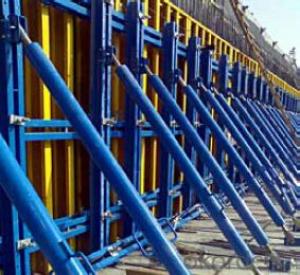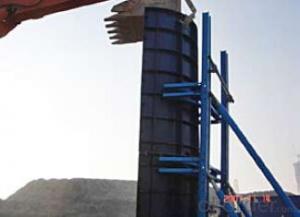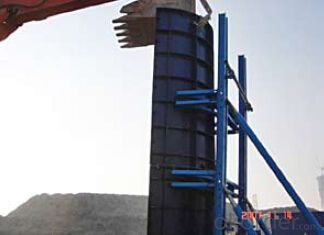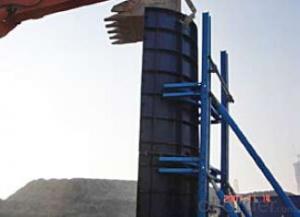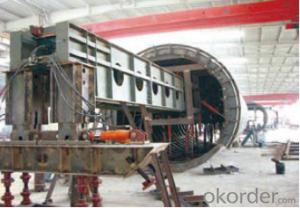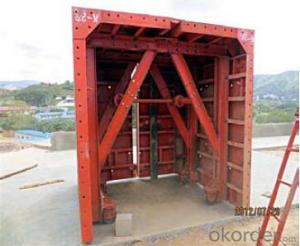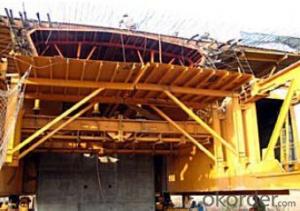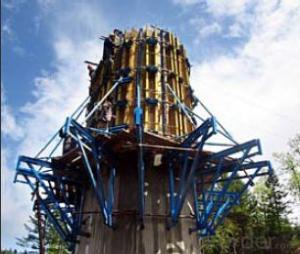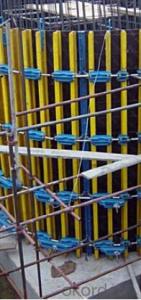Building Bridge Tunnel Formwork and Scaffolding System
- Loading Port:
- Tianjin
- Payment Terms:
- TT OR LC
- Min Order Qty:
- 50 m²
- Supply Capability:
- 1000 m²/month
OKorder Service Pledge
Quality Product, Order Online Tracking, Timely Delivery
OKorder Financial Service
Credit Rating, Credit Services, Credit Purchasing
You Might Also Like
Building Bridge&Tunnel Formwork:
A compositional steel formwork system mainly used in the building which has regular structure
without beams, the excellent formwork system can make the integral pouring for the wall & slab
easily achieved.
Characteristics:
◆ No assembling, easy operation with formed formwork.
◆ High stiffness, make perfect shape for concrete.
◆ Repeatedly turnover is available.
◆ Widely applied range, such as building, bridge, tunnel, etc.

- Q: How does steel formwork handle concrete vibration during pouring?
- Steel formwork is designed to withstand the forces and pressures generated during concrete pouring and vibration. It provides a rigid and stable structure that can effectively handle the vibrations caused by the pouring process. The steel formwork is securely fixed in place, ensuring that it remains steady and does not deform or collapse under the impact of concrete vibration. Additionally, the steel material used in formwork construction has high strength and durability, allowing it to withstand the mechanical stress and vibrations induced by the pouring process without compromising its integrity.
- Q: Can steel formwork be used for stadium construction projects?
- Yes, steel formwork can be used for stadium construction projects. Steel formwork refers to the use of steel panels and frames to create temporary molds or structures for pouring concrete. This method is widely used in construction projects, including stadium construction, due to its durability, strength, and reusability. Stadium construction projects often require large-scale concrete pouring for various elements such as foundations, beams, columns, and slabs. Steel formwork provides the necessary support and stability during the concrete pouring process, ensuring accurate and precise concrete placement. Moreover, steel formwork can withstand the high pressures of concrete pouring, making it suitable for large-scale projects like stadiums. Steel formwork also offers several advantages over traditional formwork materials such as timber or plywood. Firstly, steel formwork is highly durable and can be used for multiple construction cycles, making it cost-effective in the long run. Secondly, steel formwork provides better dimensional accuracy and consistency, resulting in better quality concrete structures. Additionally, steel formwork is fire-resistant, weather-resistant, and can be easily cleaned and maintained. Furthermore, steel formwork can be customized and fabricated according to the specific design requirements of the stadium. This flexibility allows for efficient and precise construction, ensuring that the stadium's structural elements are built to the desired specifications. In conclusion, steel formwork is a suitable and preferred choice for stadium construction projects. Its strength, durability, reusability, and customization options make it an ideal solution for creating temporary molds and structures during the concrete pouring process.
- Q: How does steel formwork affect the overall construction site logistics?
- Steel formwork can significantly impact the overall construction site logistics in a positive way. Its durability and reusability allow for faster and more efficient construction processes, reducing the need for frequent replacements. Additionally, the modular nature of steel formwork enables easy assembly and dismantling, saving time and labor costs. This type of formwork also provides precise and consistent results, ensuring higher quality construction. Overall, the use of steel formwork enhances productivity, streamlines logistics, and contributes to smoother operations at the construction site.
- Q: Can steel formwork be used for projects with limited formwork assembly time?
- Yes, steel formwork can be used for projects with limited formwork assembly time. Steel formwork is known for its durability and strength, making it a suitable choice for projects that require quick assembly and demobilization. Unlike traditional timber formwork, steel formwork can be easily assembled and dismantled, reducing the overall construction time. Additionally, steel formwork is reusable, allowing for cost savings and increased efficiency on future projects. Overall, steel formwork is a reliable solution for projects with limited formwork assembly time.
- Q: How does steel formwork compare to other formwork materials in terms of durability?
- Steel formwork is known for its exceptional durability compared to other formwork materials. Its strength and resilience make it capable of withstanding heavy loads and harsh weather conditions, ensuring long-term stability and reliability. Unlike wooden or plastic alternatives, steel formwork does not warp, rot, or deteriorate over time, making it a highly preferred choice for construction projects that require long-lasting and robust formwork solutions.
- Q: How does steel formwork affect the overall sustainability of a construction project?
- The overall sustainability of a construction project can be significantly influenced by the use of steel formwork. Firstly, the durability and reusability of steel formwork greatly reduces the need for constant replacement, resulting in minimal waste generation and a reduced environmental footprint. This not only benefits the project's environmental impact but also aids in cost reduction. Additionally, the use of steel formwork ensures a high level of accuracy and precision, leading to efficient and streamlined construction processes. This in turn reduces material wastage and energy consumption, contributing to the sustainable use of resources. Moreover, the utilization of steel formwork enables faster construction cycles, resulting in decreased overall energy consumption and greenhouse gas emissions. Furthermore, steel formwork offers versatility in design, allowing for the creation of complex and innovative architectural structures. This versatility enhances the aesthetic appeal of a building, promoting its long-term use and decreasing the likelihood of demolitions due to outdated designs. By extending the lifespan of a structure, steel formwork contributes to the sustainability of the project by reducing the need for additional construction and material usage. In addition, steel formwork plays a crucial role in ensuring the overall structural integrity and safety of a building. Its strength and rigidity provide stability during both construction and throughout the lifespan of the structure. This reduces the risk of structural failures and the need for repairs or reconstruction, consequently minimizing waste generation and resource depletion. To summarize, the use of steel formwork has various positive impacts on the overall sustainability of a construction project. Its durability, reusability, precision, efficiency, versatility, and structural integrity contribute to the reduction of waste generation, energy consumption, and greenhouse gas emissions. By promoting the sustainable use of resources and contributing to the long-term viability of buildings, steel formwork plays a crucial role in sustainable construction practices.
- Q: Can steel formwork be used in areas with high humidity levels?
- Yes, steel formwork can be used in areas with high humidity levels. Steel is a durable and corrosion-resistant material, which makes it suitable for use in humid environments. However, it is important to ensure proper maintenance and protective coatings are applied to prevent rust and corrosion. Additionally, using steel formwork in high humidity areas may require more frequent inspections and maintenance to ensure its longevity and structural integrity.
- Q: How does steel formwork affect the overall thermal performance of the building?
- Steel formwork does not directly affect the overall thermal performance of the building as it is primarily used in the construction process for shaping and supporting concrete structures. However, if steel formwork is not properly insulated or if there are gaps between the formwork and the concrete, it can contribute to thermal bridging, which can negatively impact the building's energy efficiency.
- Q: Can steel formwork be used for high-rise construction projects?
- Yes, steel formwork can be used for high-rise construction projects. Steel formwork is known for its strength and durability, making it suitable for heavy-duty applications such as high-rise construction. It provides excellent stability and support to the concrete during the pouring and curing process, ensuring the structural integrity of the building. Additionally, steel formwork can be easily assembled and disassembled, making it efficient for use in tall structures where multiple floors need to be constructed. Its reusable nature also allows for cost savings in the long run. Overall, steel formwork is a reliable and popular choice for high-rise construction projects.
- Q: Can steel formwork be used for both above-ground and below-ground structures?
- Yes, steel formwork can be used for both above-ground and below-ground structures.
Send your message to us
Building Bridge Tunnel Formwork and Scaffolding System
- Loading Port:
- Tianjin
- Payment Terms:
- TT OR LC
- Min Order Qty:
- 50 m²
- Supply Capability:
- 1000 m²/month
OKorder Service Pledge
Quality Product, Order Online Tracking, Timely Delivery
OKorder Financial Service
Credit Rating, Credit Services, Credit Purchasing
Similar products
Hot products
Hot Searches
Related keywords
